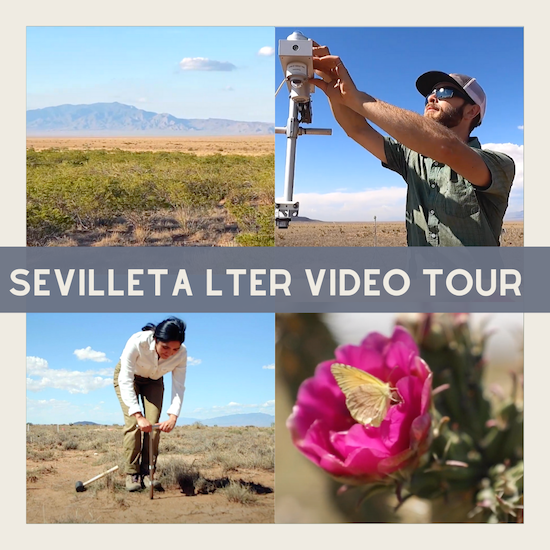Video tour of the Sevilleta Long-Term Ecological Research experiments
UNM Biology Professor Jenn Rudgers leads a team of researchers at one of the largest NSF projects in New Mexico, the Sevilleta Long-Term Ecological Research project. Scientists at the Sevilleta National Wildlife Refuge are examining various aspects of climate change. See our videos of the work being done at the site south of Albuquerque.
Core Site Long-Term Ecological Monitoring
Lauren Baur, Program Manager for the Sevilleta Long Term Ecological Research program at the University of New Mexico, leads a research team in ecological data collection that monitors population dynamics, community structure, and ecosystem processes.
Mean-Variance Climate Experiment
Brooke Wainwright, a graduate student at the University of New Mexico with the Sevilleta Long Term Ecological Research program, describes the signature experiment of the 2018-2024 program: The Mean – Variance Climate Experiment. This experiment factorially manipulates the average (mean) and variability (variance) in soil moisture to understand ecological responses to predicted climates of the future.
Small Mammal Monitoring and Physiology
Dr. Phil Manlick, Postdoctoral Research Scientist in the Biology Department at the University of New Mexico and his colleagues with the Sevilleta Long Term Ecological Research program have been studying small mammal foraging ecology in dryland ecosystems to understand how these animals will respond to future climates that are drier and more variable.
Evolutionary and Trait Monitoring
Ben Gerstner, a PhD student in Biology at the University of New Mexico (UNM), explains ongoing work by the Sevilleta Long-Term Ecological Research (SEV-LTER) program to monitor species traits and evolutionary change in response to ongoing shifts in the mean (average) and variability of climate.
Extreme Drought in Grasslands Experiment (EDGE)
Vanessa Fernandes, a postdoctoral researcher with the Sevilleta Long-Term Ecological Research (SEV-LTER) program at the University of New Mexico, describes the Extreme Drought in Grasslands Experiment at two sites at the Sevilleta: Great Plains grassland and Chihuahuan Desert grassland. The treatments include extreme drought and delayed monsoon.
Core Site Bee Monitoring
Fredo Garcia, a Research Technician at the University of New Mexico, explains the long-term bee monitoring project of the Sevilleta Long Term Ecological Research program. Monthly bee trapping at the Sevilleta National Wildlife Refuge forms the core of the world’s longest continuous bee monitoring program.
New Mexico Elevation Gradient - Flux Towers
Mikael Schlumpf, a research scientist in the Litvak Lab in the Biology Department at the University of New Mexico, explains long-term monitoring of ecosystem fluxes in drylands of the southwestern U.S.A.
Global Change Experiment: WENNDEx
Mariah Patton, a PhD student in Biology at the University of New Mexico, explains the Warming-El Nino-Nitrogen Deposition Experiment (WENNDEx) maintained with funding to the Sevilleta Long-Term Ecological Research (SEV-LTER) program and the National Science Foundation’s Long-Term Research in Environmental Biology (LTREB) program.
Fire Seasonality Experiment and Prescribed Fire Management
Scott Collins (Professor of Biology, University of New Mexico) and Paulette Ford (1965-2021), a Research Ecologist with the USDA Forest Service’s Rocky Mountain Research Station, describe the importance of understanding fire management in dryland ecosystems of the southwestern US.
Soil Disturbance to Biocrusts (STOMP Experiment)
Cassandra Miller (PhD student in Biology and the University of New Mexico) and Dylan Taylor (Research Experience for Undergraduates student, Aurora College) explain an ongoing soil disturbance experiment conducted by the Sevilleta Long Term Ecological Research program. Disturbances, such as physical disturbances to soil surfaces caused by humans or animals, may modulate the sensitivity of populations, communities and ecosystem processes to changes in the mean and variance of climate.
Fertilization Experiment: NutrientNetwork
Purbandra Yogi, a graduate student at the University of New Mexico with the Sevilleta Long Term Ecological Research (SEV-LTER) program, is collecting data on soils from the Sevilleta installation of the Nutrient Network (NutNet) project, a global research collective that studies the effects of eutrophication (nutrient additions) to grassland ecosystems across the planet.


